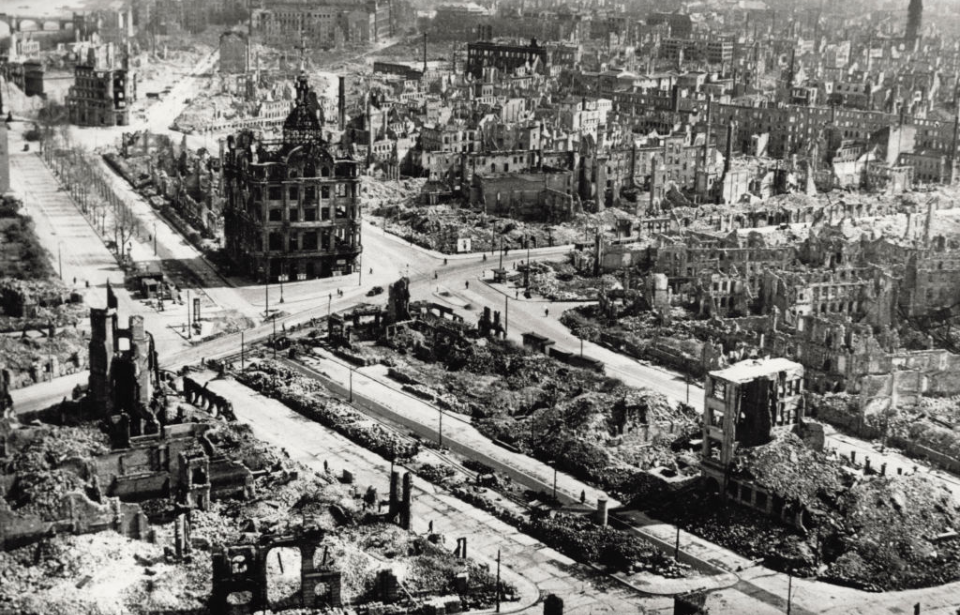The Bombing of Dresden, Germany stands as one of the most controversial events of the Second World War and is a stark symbol of the devastation wrought by aerial warfare. In February 1945, this once-picturesque city, known as “Florence on the Elbe” for its stunning architecture and art, became the target of an Allied aerial assault, and its fate during the final months of the conflict left an indelible mark on the collective memory.
Strategic importance of Dresden during World War II
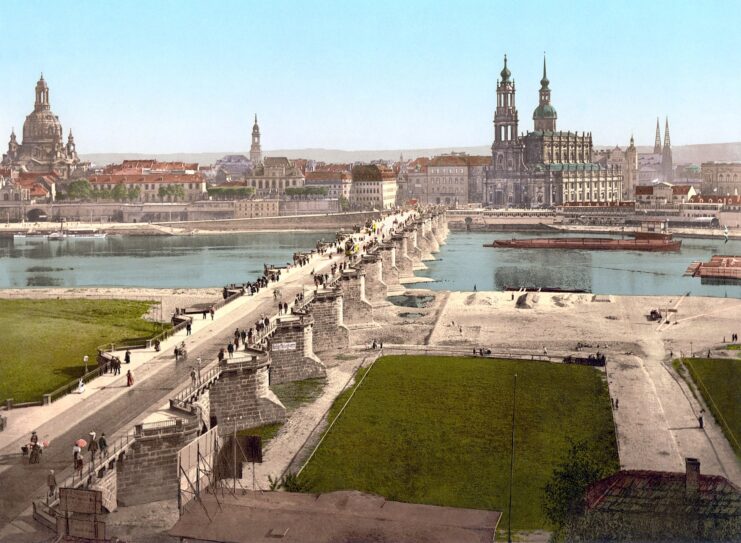
Dresden, 1890s. (Photo Credit: Detroit Publishing Co. / Library of Congress’ Prints and Photographs Division / Wikimedia Commons / Public Domain)
As World War II raged on, Dresden’s strategic importance became increasingly significant. Located in eastern Germany, it wasn’t just a picturesque city with Baroque architecture and cultural treasures; it was also a vital transportation hub.
Railways running from the area connected the Eastern and Western Fronts, allowing for the swift movement of German troops and equipment – it was just 155 miles from the East. This logistical significance made Dresden a target of interest for the Allies, who sought to disrupt the Germans’ military operations and hasten the end of the war.
Moreover, Dresden housed important industrial complexes that contributed to the German war machine. While not as heavily industrialized as other cities, its factories produced precision optical equipment, electronics and military hardware; Dresden’s infrastructure supported German war efforts subtly but critically.
What led up to the Allied bombing of Dresden?
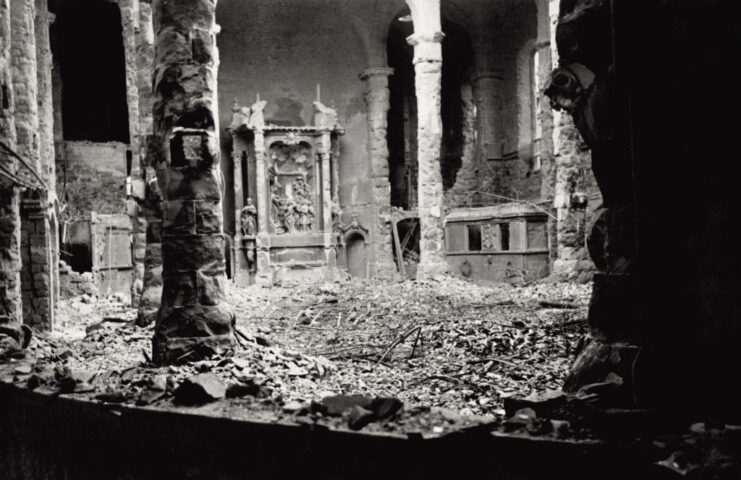
Remains of a church following the bombing of Dresden, 1945. (Photo Credit: Mondadori / Getty Images)
The Allies’ desire to bomb key areas of German-occupied land wasn’t a secret during the Second World War, with British Prime Minister Winston Churchill calling for increased British air raids throughout the conflict. These only increased as the Luftwaffe‘s strength decreased (particularly following Operation Bodenplatte) and the size of the Allies’ bomber fleets increased.
The decision to launch an aerial assault on Dresden was influenced by the desire to aid the Soviet advance and undermine the morale of the German populace. The city swelled with hundreds of thousands of refugees fleeing the Red Army’s advance into Silesia, adding to the complexity of the situation.
As the plans for the assault were finalized, little did the residents of Dresden know that their city would become synonymous with one of the most controversial bombings of the Second World War.
Dresden engulfed in flames
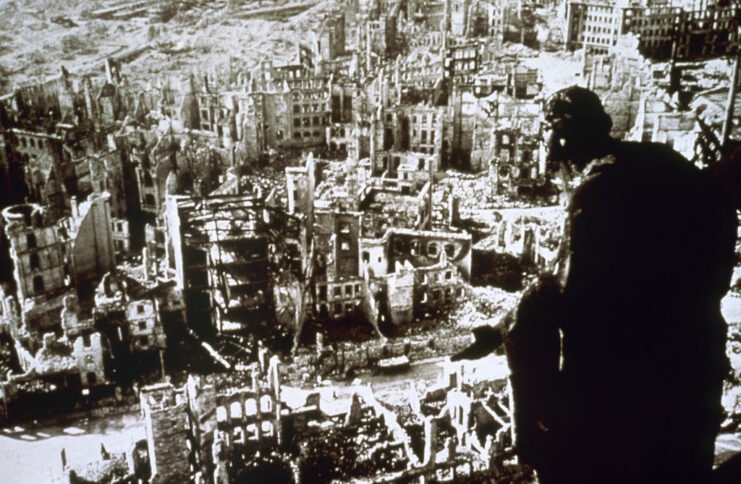
Dresden following the Allied bombing of the city, 1945. (Photo Credit: Prisma / UIG / Getty Images)
As the bombing of Dresden commenced, the city was soon swallowed up by an inferno that scarred its landscape and history. Beginning at around 10:00 PM on the night of February 13, 1945, the British sent 800 bombers, led by pathfinders dropping flares, to attack the city, which dropped 2,700 tons of incendiaries and explosives over the German city. While there had been hopes the air raid would begin earlier, poor weather prevented daytime action.
The amount of munitions dropped from overhead created a massive firestorm, a phenomenon that occurs when fires become so extensive that they create their own weather system. The temperature soared, and the air itself seemed to ignite, turning Dresden into a literal furnace. The firestorm was so intense that it could be seen from miles away.
The next day, the Eighth Air Force, under the US Army Air Forces (USAAF), dropped another 400 tons of bombs from Boeing B-17 Flying Fortresses, with the assault coming to a close on February 15, after nearly 4,000 tons of munitions had been deployed.
Dresden was destroyed
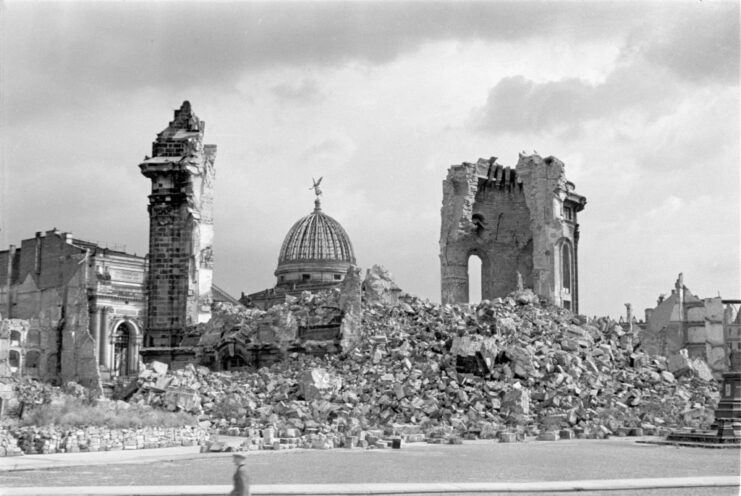
Ruins of the Dresden Frauenkirche, 1945. (Photo Credit: Deutsche Fotothek / picture alliance / Getty Images)
It’s estimated that between 22,700 and 25,000 civilians lost their lives in the bombing of Dresden, with many of the deceased treated poorly over fears of disease.
A 1953 report found that 50 percent of residential buildings and 23 percent of industrial structures had been destroyed or severely damaged, with over 90 percent of the city center obliterated. In contrast, the Allies only lost seven aircraft. The Americans saw one destroyed, while the British experienced six, three of which were the result of hitting each other with their own bombs.
In the wake of the Allied bombing, Dresden’s historical center lay in ruins, with landmarks like the Zwinger, the Semperoper and the Cathedral severely damaged or destroyed. The air raid decimated the city’s infrastructure, leaving survivors amid a landscape of ash and rubble. The impact was felt not just in the immediate loss of life and destruction of property, but in the deep wounds it inflicted on the cultural heart of Dresden.
Controversy surrounding the bombing of Dresden
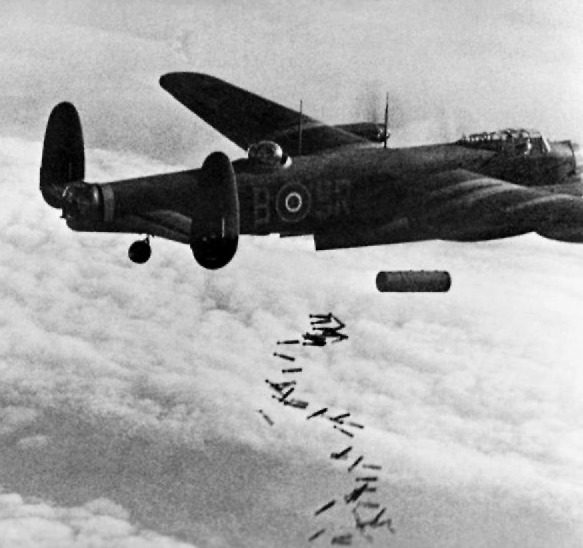
Avro Lancaster dropping munitions, 1944. (Photo Credit: United Kingdom Government / Wikimedia Commons / Public Domain)
The bombing of Dresden has long been mired in contention, sparking debates that question the necessity and morality of the air raid. Critics argue the city was of limited strategic value, suggesting the assault was excessive and even a war crime. They point to its reputation as a cultural landmark, rather than an industrial powerhouse, and the high civilian casualties as evidence that what occurred wasn’t justified by military necessity.
The German regime used this point as propaganda, arguing that Dresden wasn’t home to anything that aided the war effort and claiming that upwards of 200,000 civilians had been senselessly killed.
This controversy is fueled by varying casualty estimates and the fact the Second World War was nearing its end following the high German losses during the Battle of the Bulge, leading some to believe the bombing was more of a political statement or an act of retribution, rather than a strategic move.
Even Winston Churchill, for all his talk, questioned the bombing, writing in a memo, “It seems to me that the moment has come when the question of bombing of German cities simply for the sake of increasing the terror, though under other pretexts, should be reviewed. The destruction of Dresden remains a serious query against the conduct of Allied bombing.”
On the other side of the debate, defenders emphasize the city’s role in German military logistics, including the transportation and communication networks critical to the war effort. They argue that Dresden was a legitimate military target, meaning any inaction would have hindered the upcoming Soviet offensive.
Furthermore, they contend the attack hastened the war’s end, saving lives that would have been lost in a protracted conflict.
Rebuilding Dresden following World War II
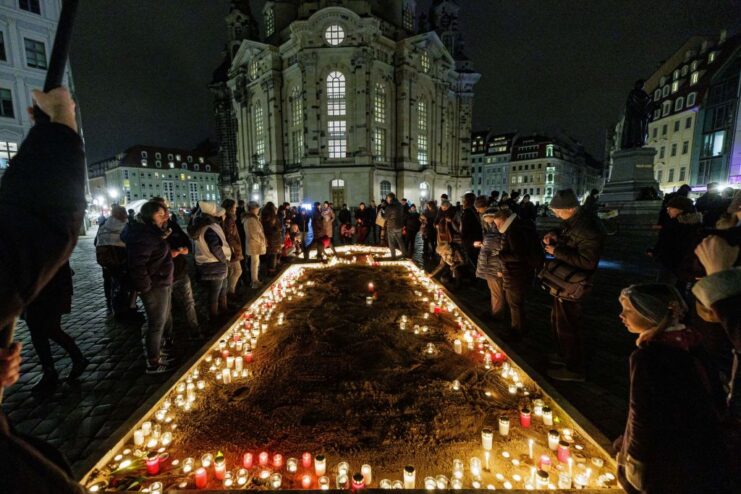
Residents of Dresden commemorating the 78th anniversary of the city’s bombing during World War II, 2023. (Photo Credit: JENS SCHLUETER / AFP / Getty Images)
In the wake of the bombing of Dresden, the city was left in ruins. The immediate aftermath was marked by a staggering loss of life and the immense challenge of addressing the humanitarian needs of survivors. Yet, amid the devastation, the spirit of Dresden’s citizens shone as they embarked on the arduous journey of rebuilding their beloved city.
Reconstruction efforts began soon after WWII came to a close, with it initially proposed that the entire city be demolished and rebuilt from the ground up. This didn’t sit well with locals, who took the lead in clearing debris and salvaging what they could from the wreckage. The priority was to create habitable spaces and restore essential services.